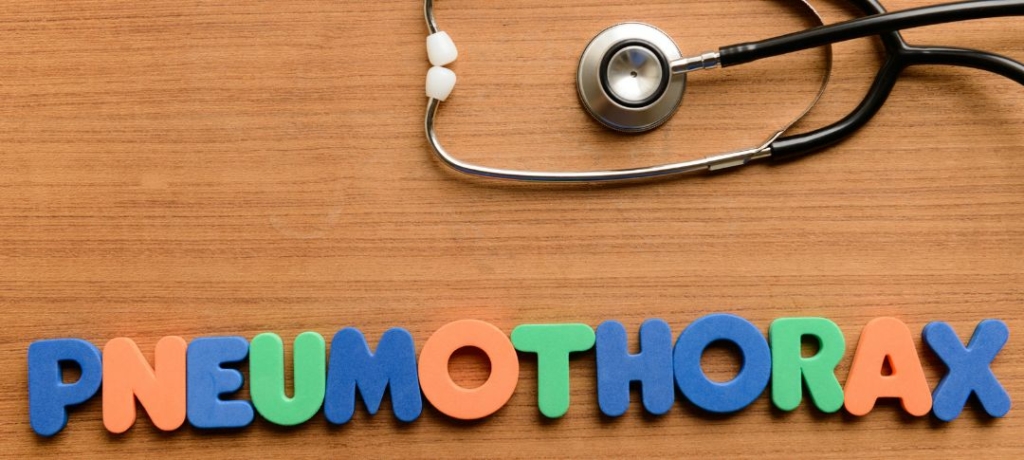
Pneumothorax, or a collapsed lung, is one of the risks of en bloc implant removal
Pneumothorax complication occurs when air builds up in the chest cavity and prevents the lung from expanding normally.
A lung may collapse only partially and heal by itself, or it can become a life-threatening condition and require surgery. Patients with a collapsed lung following implant removal with en bloc capsulectomy usually experience sudden chest pain and difficulty breathing.
Learn more about the risk of pneumothorax after en bloc implant removal, what causes it, its treatment options, and what surgeons can do to prevent it.
What Is Pneumothorax After En Bloc Implant Removal?
Pneumothorax happens when air leaks into the space between your chest and your lung, which causes the lung to collapse. It’s a complication that can develop after cosmetic surgeries such as breast implant surgery and abdominoplasty.
A collapsed lung can also occur after en bloc implant removal, a surgery to manage complications following breast augmentation. These complications include breast implant-associated anaplastic large-cell lymphoma (BIA-ALCL), breast implant illness (BII), or silicone implant rupture.
“En bloc” means “all together” or “at the same time”. En bloc implant removal, also known as en bloc explant and en bloc capsulectomy, is the removal of a breast implant and its entire surrounding capsule of scar tissue as one piece.
One prospective study reported that 3.8% of patients who received en-bloc implant resection for BIA-ALCL management developed a collapsed lung.
The main symptoms of pneumothorax following en bloc removal of a breast implant are:
- Sudden chest pain or discomfort
- Shortness of breath
- Rapid breathing and fast heartbeats
- Skin turning blue from the lack of oxygen
- A dry cough
Patients who get new implants after en bloc implant removal may also experience the following symptoms of a collapsed lung:
- Difficulty breathing after getting breast implants
- Breast implants hurt when they breathe
What Causes Pneumothorax after En Bloc Implant Removal?
Pneumothorax happens when the air in the lungs escapes outside and fills the chest cavity (the space between the lungs and the chest wall).
The build up of air in the chest cavity puts pressure on the lungs and prevents them from expanding as much as they usually do when you take a breath. As a result, the lungs collapse. This condition is medically known as pneumothorax.
The following can cause a collapsed lung after breast implant removal with en bloc capsulectomy:
· Dissection into the chest muscle
During en bloc capsulectomy, the surgeon makes an incision to remove the entire breast implant contained within the scar tissue capsule along with a continuous layer of healthy tissue.
In the case of submuscular (under the muscle) breast implants, the capsule of scar tissue surrounding the implant often sticks to the underlying ribs.
In the attempt to entirely remove the capsule containing the submuscular implant, the surgeon might accidentally dissect the underlying chest muscles.
Consequently, the injury to the chest muscles can cause pneumothorax following en bloc implant removal.
· Needle injury during injection of local anaesthetics
The pectoral nerve (Pecs) blocks are novel local anaesthetics that can relieve pain after breast surgery. During en bloc capsulectomy, Pecs blocks are injected into the chest muscles to numb them and minimise pain after surgery.
The lungs may collapse after en bloc capsulectomy if the needle tip reaches the pleura (the membrane covering the lungs) and ruptures it while injecting the nerve blocks.
· Mechanical ventilation
General anaesthesia relaxes the muscles in your airway and makes it difficult to breathe on your own. Therefore, mechanical ventilation is used to help patients breathe when undergoing surgery under general anaesthesia, such as en bloc implant removal.
In some cases, the ventilator creates an imbalance in the air pressure inside the chest. That can cause lung collapse (pneumothorax) after removal of breast implants with en bloc capsulectomy.
Spontaneous pneumothorax
A lung may collapse for no known reasons following en bloc capsulectomy.
Treatment of Pneumothorax after En Bloc Implant Removal
Your surgeon can confirm a pneumothorax diagnosis using a chest X-ray, computerised tomography (CT), or ultrasound imaging.
To treat a collapsed lung after en bloc implant removal, the surgeon needs to relieve the pressure on the lung so it can re-expand normally.
Depending on the cause of the pneumothorax, further steps might be needed to prevent it from recurring.
Pneumothorax management after en bloc implant removal can be done by:
1. Observation
A small pneumothorax after breast implant removal with en bloc capsulectomy may heal on its own.
Initially, your surgeon may stick to monitoring your condition with a series of X-ray images if the size of the pneumothorax is small or only part of the lung has collapsed.
It might take several weeks until the excess air in the chest wall becomes completely reabsorbed by the body and the lungs expand again.
You may also be given high-flow oxygen through a breathing tube to help your lungs re-expand.
2. Needle aspiration
The management of significant pneumothorax following en bloc implant removal usually requires needle aspiration.
Your surgeon will insert a catheter (a needle with a thin, flexible tube) between the ribs into the air-filled chest wall. Then, a syringe is attached to the catheter to suck out the excess air and relieve the pressure on the collapsed lung. After that, the lung should begin to expand again.
Your surgeon may leave the catheter in for a few hours to ensure that the pneumothorax does not recur.
3. Chest tube insertion (thoracostomy)
Pneumothorax treatment after en bloc capsulectomy may require thoracostomy.
Thoracostomy (chest tube placement) is a minimally invasive procedure where the surgeon inserts a chest tube into the area between the lungs and the chest wall.
Your surgeon makes a small incision between the ribs to insert a chest tube (a hollow, flexible tube) into the chest cavity. It may be attached to a one-way valve that helps it remove excess air outside the lungs.
The chest tube continuously drains the built-up air from the chest cavity until the lungs re-expand and heal.
4. Non-surgical treatment
Non-surgical pneumothorax treatment options are available for patients not fit for surgery.
Lung collapse after en bloc capsulectomy can be treated without surgery using:
Pleurodesis
Pleurodesis can treat pneumothorax if the lungs can’t expand after chest tube insertion. It’s a procedure that makes the lung stick to the chest wall to help seal any air leaks.
Pleurodesis to treat lung collapse after en bloc implant removal can be done using:
- Irritants: your surgeon injects an irritant, such as doxycycline or talc, through the chest tube and into the chest cavity. The irritating substance causes inflammation in the tissues surrounding the lungs. As a result, the tissues adhere tightly to each other and heal any air leaks
- Autologous blood patch pleurodesis: your surgeon inserts blood drawn from your arm through the chest tube. The blood clots and forms a patch over the lungs, which seals the air leaks
Bronchoscopy
During bronchoscopy, your surgeon inserts a thin tube (bronchoscope) through your mouth or nose. The bronchoscope passes down your throat into your lungs.
Using a one-way valve, the bronchoscope allows the excess air to flow out of the chest wall until the air leaks to heal.
5. Surgery
Sometimes, surgery is needed to treat a collapsed lung after en bloc implant removal and prevent the pneumothorax from recurring.
Usually, the surgeon makes one or more small incisions in the chest. A tiny fiber-optic camera and long surgical instruments are inserted into the chest wall through the incisions. Then, the surgeon will look for and close off any air leaks using the camera and the surgical tools. This procedure is known as video-assisted thoracoscopic surgery (VATS).
In rare cases, the surgeon will make a large incision in the chest to reach and repair the air leaks.
Can You Prevent Pneumothorax After En Bloc Implant Removal?
The following can help surgeons minimise the risk of lung collapse following breast implant removal with en bloc capsulectomy:
- Ultrasound-guided nerve block injections: ultrasound guidance aids surgeons in visualising the different layers of the chest. The ultrasound images allow surgeons to keep the needle tip within view while injecting the Pecs block into the chest muscles. That helps them avoid puncturing the lung membrane during en bloc implant removal, which can result in a collapsed lung
- Careful dissection techniques: highly skilled surgeons can avoid pneumothorax after en bloc capsulectomy by using precise and delicate dissection techniques. Careful dissection of the submuscular implant with the capsule helps avoid cutting into the chest muscles and minimises the risk of lung collapse
What to Do After Pneumothorax Surgery?
Several tips can help you heal faster and prevent a pneumothorax from returning after surgery, such as:
- Don’t smoke: smoking increases the risk of a collapsed lung. After your pneumothorax surgery or treatment, don’t smoke and avoid being around people who smoke
- Avoid changes in air pressure: avoid doing things that expose you to drastic changes in air pressure, such as scuba diving, deep-sea diving, or flying in an airplane until your doctor clears it
- Avoid straining your chest muscles: avoid activities that may strain your chest muscles. Heavy lifting, laughing, and coughing can all exert the chest muscles and increase the pressure on your lungs
Follow-up care is a big part of your pneumothorax treatment, so make sure you follow your surgeon’s instructions carefully after pneumothorax surgery or other treatment options.
Is Pneumothorax A Dangerous Complication?
In some cases, pneumothorax after en bloc implant removal can go away without treatment. In other cases, it can be a life-threatening complication.
Seek immediate medical attention if you have trouble breathing or feel a sharp pain in your chest after surgery to remove your implants with en bloc capsulectomy.
Medical References about Pneumothorax and En Bloc Implant Removal
- Stepwise En Bloc Resection of Breast Implant-Associated Anaplastic Large Cell Lymphoma with Oncologic Considerations – PMC
- Impact of Capsulectomy Type on Post-Explantation Systemic Symptom Improvement: Findings From the ASERF Systemic Symptoms in Women-Biospecimen Analysis Study: Part 1 – PMC
- To Bloc or Not to Bloc: Challenges in the Management of Patients Requesting “En-Bloc Capsulectomy” – PMC
- Impact of Capsulectomy Type on Post-Explantation Systemic Symptom Improvement: Findings From the ASERF Systemic Symptoms in Women-Biospecimen Analysis Study: Part 1 – PMC
- Pneumothorax as a Complication of Liposuction | Aesthetic Surgery Journal | Oxford Academic
- Breast Implant Removal FAQs – Carmen Munteanu’s Best Answers
- BREAST IMPLANTS Gallery by Dr Guy Watts
- Breast Implant Removal Sydney – Soliman Plastic Surgery
- Should I Have An En Bloc Capsulectomy? – Dr Michael Kernohan





